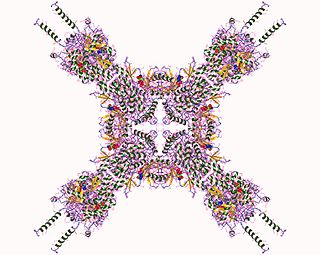
Uridine diphosphate N-acetylglucosamine or UDP-GlcNAc is a nucleotide sugar and a coenzyme in metabolism. It is used by glycosyltransferases to transfer N-acetylglucosamine residues to substrates. D-Glucosamine is made naturally in the form of glucosamine-6-phosphate, and is the biochemical precursor of all nitrogen-containing sugars. To be specific, glucosamine-6-phosphate is synthesized from fructose 6-phosphate and glutamine as the first step of the hexosamine biosynthesis pathway. The end-product of this pathway is UDP-GlcNAc, which is then used for making glycosaminoglycans, proteoglycans, and glycolipids.
In enzymology, a N-acetylglucosaminylphosphatidylinositol deacetylase (EC 3.5.1.89) is an enzyme that catalyzes the chemical reaction
In enzymology, a dolichyl-phosphate alpha-N-acetylglucosaminyltransferase is an enzyme that catalyzes the chemical reaction
In enzymology, an indolylacetylinositol arabinosyltransferase is an enzyme that catalyzes the chemical reaction
In enzymology, a phosphatidylinositol N-acetylglucosaminyltransferase is an enzyme that catalyzes the chemical reaction

In enzymology, a 1-phosphatidylinositol 4-kinase is an enzyme that catalyzes the chemical reaction

Mycothiol is an unusual thiol compound found in the Actinomycetota. It is composed of a cysteine residue with an acetylated amino group linked to glucosamine, which is then linked to inositol. The oxidized, disulfide form of mycothiol (MSSM) is called mycothione, and is reduced to mycothiol by the flavoprotein mycothione reductase. Mycothiol biosynthesis and mycothiol-dependent enzymes such as mycothiol-dependent formaldehyde dehydrogenase and mycothione reductase have been proposed to be good drug targets for the development of treatments for tuberculosis.
Mycothiol synthase is an enzyme with systematic name acetyl-CoA:desacetylmycothiol O-acetyltransferase. This enzyme catalyses the following chemical reaction
Alpha-1,6-mannosyl-glycoprotein 4-beta-N-acetylglucosaminyltransferase is an enzyme with systematic name UDP-N-acetyl-D-glucosamine:2,6-bis(N-acetyl-beta-D-glucosaminyl)-alpha-D-mannosyl-glycoprotein 4-beta-N-acetyl-D-glucosaminyltransferase. This enzyme catalyses the following chemical reaction
Glucuronosyl-N-acetylglucosaminyl-proteoglycan 4-alpha-N-acetylglucosaminyltransferase is an enzyme with systematic name UDP-N-acetyl-D-glucosamine:beta-D-glucuronosyl-(1->4)-N-acetyl-alpha-D-glucosaminyl-proteoglycan 4-alpha-N-acetylglucosaminyltransferase. This enzyme catalyses the following chemical reaction
N,N'-diacetylchitobiose phosphorylase is an enzyme with the systematic name N,N'-diacetylchitobiose:phosphate N-acetyl-D-glucosaminyltransferase. This enzyme was found in the genus Vibrio initially but has now been found to be taken up by Escherichia coli as well as many other bacteria. One study shows that Escherichia coli can replicate on a medium that is just composed of GlcNAc a product of phosphorylation of N,N'-diacetylchitobiose as the sole source of carbon. Because E. coli can go on this medium, the enzyme is present. The enzyme has also been found in multiple eukaryotic cells as well, especially in eukaryotes that make chitin and break chitin down. It is believed that N,N'-diacetylchitobiose phosphorylase is an integral part of the phosphoenolpyruvate:glucose phosphotransferase system (PTS). It is assumed that it is involved with Enzyme Complex II of the PTS and is involved with the synthesis of chitin. The enzyme is specific for N,N'-diacetylchitobiose.
UDP-4-amino-4,6-dideoxy-N-acetyl-alpha-D-glucosamine transaminase is an enzyme with systematic name UDP-4-amino-4,6-dideoxy-N-acetyl-alpha-D-glucosamine:2-oxoglutarate aminotransferase. This enzyme catalyses the following chemical reaction
UDP-N-acetylglucosamine kinase is an enzyme with systematic name ATP:UDP-N-acetyl-alpha-D-glucosamine 3'-phosphotransferase. This enzyme catalyses the following chemical reaction
UDP-N-acetylgalactosamine diphosphorylase is an enzyme with systematic name UTP:N-acetyl-alpha-D-galactosamine-1-phosphate uridylyltransferase. This enzyme catalyses the following chemical reaction
UDP-N-acetylglucosamine—undecaprenyl-phosphate N-acetylglucosaminephosphotransferase is an enzyme with systematic name UDP-N-acetyl-alpha-D-glucosamine:ditrans,octacis-undecaprenyl phosphate N-acetyl-alpha-D-glucosaminephosphotransferase. This enzyme catalyses the following chemical reaction
UDP-N-acetylglucosamine 2-epimerase (hydrolysing) (EC 3.2.1.183, UDP-N-acetylglucosamine 2-epimerase, GNE (gene), siaA (gene), neuC (gene)) is an enzyme with systematic name UDP-N-acetyl-alpha-D-glucosamine hydrolase (2-epimerising). This enzyme catalyses the following chemical reaction
N-acetyl-1-D-myo-inositol-2-amino-2-deoxy-alpha-D-glucopyranoside deacetylase (EC 3.5.1.103, MshB) is an enzyme with systematic name 1-(2-acetamido-2-deoxy-alpha-D-glucopyranosyl)-1D-myo-inositol acetylhydrolase. This enzyme catalyses the following chemical reaction
UDP-2,3-diacylglucosamine diphosphatase (EC 3.6.1.54, UDP-2,3-diacylglucosamine hydrolase, UDP-2,3-diacylglucosamine pyrophosphatase, ybbF (gene), lpxH (gene)) is an enzyme with systematic name UDP-2,3-bis((3R)-3-hydroxymyristoyl)-alpha-D-glucosamine 2,3-bis((3R)-3-hydroxymyristoyl)-beta-D-glucosaminyl 1-phosphate phosphohydrolase. This enzyme catalyses the following chemical reaction
UDP-N-acetylglucosamine 4,6-dehydratase (configuration-retaining) (EC 4.2.1.135, PglF) is an enzyme with systematic name UDP-N-acetyl-α-Dglucosamine hydro-lyase (configuration-retaining; UDP-2-acetamido-2,6-dideoxy-α-Dxylo-hex-4-ulose-forming). This enzyme catalyses the following chemical reaction
L-cysteine:1D-myo-inositol 2-amino-2-deoxy-alpha-D-glucopyranoside ligase is an enzyme with systematic name L-cysteine:1-O-(2-amino-2-deoxy-alpha-D-glucopyranosyl)-1D-myo-inositol ligase (AMP-forming). This enzyme catalyses the following chemical reaction



